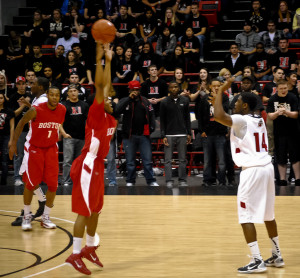What Causes a Turnover?

A Turnover in basketball, as in any sport is a wasted opportunity. It is the worst result for an offensive team as a conclusion to their possession. Nevertheless, a turnover like any event that happens on the court is very often not the result of some bad luck, but a breakdown in a tactic or strategy of the offensive team. This error can be a breakdown at the individual or team level and if not identified and corrected can be any ongoing problem, which leads to a bad habit forming.
When looking to explain what causes a turnover the most obvious place to start is in general play when the error is happening. If there appears to be no rhyme or reason to the turnovers happening during a game then consulting game footage may be of use. Like with all issues that a team is facing if the problem cannot be easily identified then video footage of a game can be a coach’s best friend. From this point, one of the good aspects about analysing game tape is that multiple games can be edited and viewed in quick succession.
One of the most common issues that lead to a turnover is players not understanding the movements of the offensive they are trying to execute. This happens in every phase of an offense, Fast Break, Primary Transition or Half-Court Offense. Every player should have an equal opportunity to learn the team’s various offenses and have ample repetitions so they are able to perform when it counts most. Anything less than this and a coach is setting their players up to fail.
Following on with this issue a coach must be active in determining how the players under tutelage learn and like to have content delivered to them. Gone are the days of a coach only being one dimensional in delivering their message. Coaches need to provide players with a variety of communication mediums to help increase each and every players understanding of what is needed and expected on court. Through this action, hopefully players can develop their knowledge and understanding faster and to a higher degree about a team’s tactics.
Another very common problem that often leads to a turnover is players rushing when they are in possession of the ball. This happens because of nerves and the players just rushing what they want to do during general play. The desire to increase the pace of play sometimes forces these types of mistakes from players. Especially if the pace desired is unfamiliar to the players because it has not been rehearsed in training or in previous game situations.
It is this hesitation or nervousness with the ball leads to players forcing passes or just taking any half opportunity that presents itself.
The best way to overcome this type of problem is to ask players to catch in a jump stop so they can pivot on either foot. Then asking players to either stop and look for opportunities in the keyway or use a fake (pass, shot or jab) to engage the defender in front of them. These very simple strategies help a player slow down their initial activity with the ball. These first few moments a players has the ball can set the tone for what they see and determine what they do with the ball.
Another common cause of a turnover is offensive players off the ball not working hard to be a good passing target. By not timing their lead for the ball, the potential receiver gives their defensive match-up an opportunity to either move closer to the passing side of the receiver or obtain a deflection outright. This is easily remedied though by ensuring offensive players show good technique in sealing their player or just creating a lead in general when attempting to receive a pass.
The second element thought to this situation is the passer and receiver making the right read about what the defence is doing. If a receiver is out of position or the defender is overplaying the passing lane. Then the passer must pass fake, which in turn triggers a back door cut by the receiver and then a pass is initiated. This simple tactical movement would be good for at least three or four situations in every game. More if the defence is overly aggressive.
Turnovers will always be a part of the game of basketball. The speed of the sport makes the scenario of no turnovers impossible. But what can be undertaken by teams is to not make the same mistakes on an ongoing basis. To learn from their errors and with each game become that little bit better.








Leave a Reply